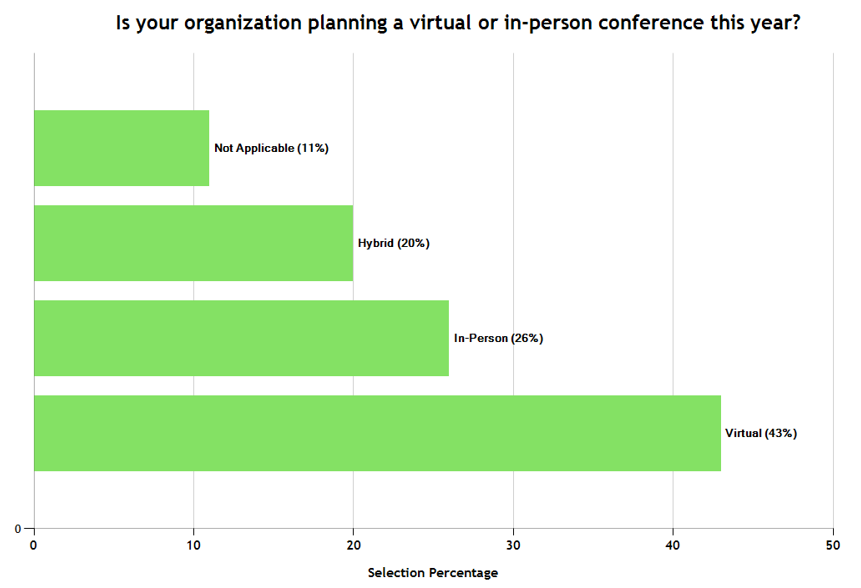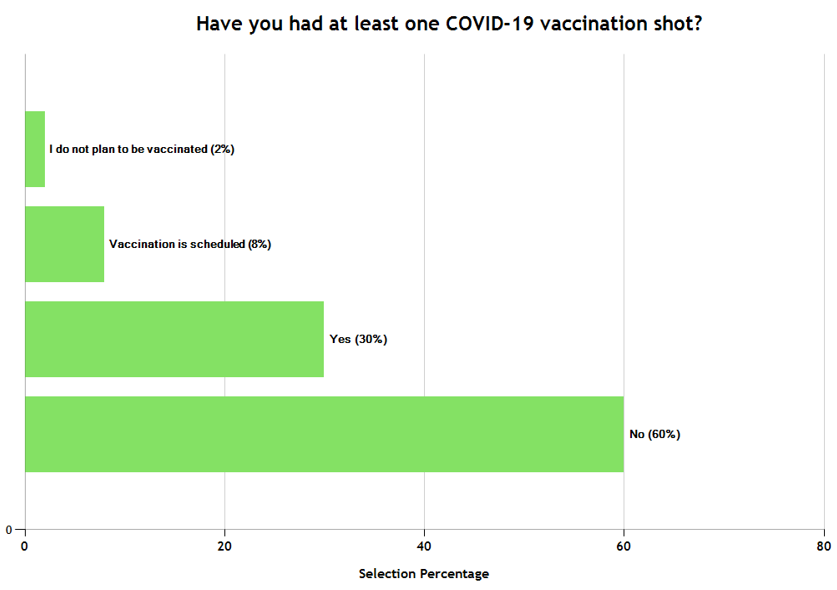
We recently conducted a short 4 question COVID related study of over 70 participants to get a pulse on how members of the association industry were feeling about vaccinations, return to work and attending conferences. What we found was interesting and falls in line with additional studies being conducted outside of the association space.
Let's analyze the results from each question.
Question #1:
The association space is ahead of the curve in terms of vaccinations. According to NPR Research, 25.7% of Americans have had at least one vaccination shot. In our study of association contacts, 30% of participants had at least one COVID shot and only 2% were not planning to be vaccinated. A national average by PEW research states that approximately 30% of Americans do not plan to be vaccinated. This is good news for the association industry in terms of vaccination infiltration and the ability to be able to return to some state of in person contact.
Question #2:

When asked about returning to work, the number that stood out was that only 25% were ready to return today yet 25% said they would return in a hybrid work environment. While only 5% of associations have fully transitioned to a remote work environment since COVID, many are making the move to a hybrid work environment. This is not solely due to feeling comfortable from a COVID perspective but also due to the productivity factor. Many association leaders have learned that their employees can be just as productive in an at home work environment and it gives their employees the bonus of the flexibility to work from home.
In a PWC study, over half of employees want to work remotely three days a week or more. Based on our research, the association industry will probably follow suit. The association industry however, in general is more social in nature. While we want the flexibility to work from home, we also want the ability to socialize with our co-workers in a non-virtual environment.
Question #3:
When participants were asked about dining indoors at a restaurant, only 47% said yes. This data point can be analyzed in many different ways due to the fact that participants in certain states haven’t had the opportunity to dine indoors. However, it falls in line with the return to work question results in the fact that approximately half of respondents were ready to return to work or return in a hybrid environment and the other half were either fully remote, not comfortable returning, or only would return after some time. This data illustrates the need for leadership to develop a plan for employees to have the option to work from home going forward for the near future.
Question #4:

To determine how associations were handling their members’ preferences for in-person versus virtual, we asked the question, Is your organization planning a virtual or in-person conference this year? Again, the numbers fell in line with what we found out in our previous results. With 43% answering all virtual and 46% either in person or some type of hybrid situation, it’s obvious that there is a consistent percentage of people that are comfortable with in person events such as dining, working and conferences but there is still a large percentage that is not.
So, What Does It All Mean?
The data is telling us that we as association leaders have to adapt to ensure we accommodate a changing landscape and changing safety tolerance levels of our team and our members. There are still many questions that remain and nobody can answer with a great deal of certainty. The larger question is, are these changes permanent or do they have a shelf life? Stay tuned....
If you’d like to conduct studies like these with your members, contact us to get started with as little as $350 a month.






